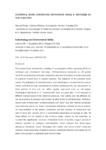Mostrar o rexistro simple do ítem
Screening acute cytotoxicity biomarkers using a microalga as test organism
| dc.contributor.author | Prado, Raquel | |
| dc.contributor.author | Rioboo, Carmen | |
| dc.contributor.author | Herrero, Concepción | |
| dc.contributor.author | Cid, Ángeles | |
| dc.date.accessioned | 2015-01-21T16:33:37Z | |
| dc.date.available | 2015-01-21T16:33:37Z | |
| dc.date.issued | 2012-12 | |
| dc.identifier.citation | Prado R, Rioboo C, Herrero C, Cid T. Screening acute cytotoxicity biomarkers using a microalga as test organism. Ecotoxicol Environ Saf. 2012;86:219-26 | es_ES |
| dc.identifier.uri | http://hdl.handle.net/2183/13943 | |
| dc.description.abstract | The present study checked the suitability of the integration of flow cytometry (FCM) as technique and a freshwater microalga (Chlamydomonas moewusii) as cell system model for ecotoxicological studies, looking for sensitive biomarkers of acute cytotoxicity of potential contaminants in aquatic systems. The detection of the potential acute toxicity of a pollutant is of interest because pulse discharges of contaminants to natural waters could lead to high concentrations of these substances that are only present for short periods of time but can affect aquatic organisms such as microalgae. Physiological alterations in C. moewusii cells were analysed after 1 h of exposure to different concentrations of the herbicide paraquat. Cell viability was not affected, but the acute toxicity of paraquat was evident at other levels of cell physiology. Herbicide-treated cells showed lower autofluorescence and higher size and internal complexity, lower esterase activity and lower mitochondrial membrane potential. Paraquat induced the depolarisation of the plasma membrane and the increase of intracellular free calcium level and cytosolic pH in a concentration-dependent percentage of cells. All these effects can be related to the oxidative stress induced by the herbicide, as revealed the significantly increased intracellular levels of reactive oxygen species in cultures exposed to paraquat concentrations which induced the physiological alterations mentioned above. Excluding cell viability and mitochondrial membrane potential, these cytotoxicity endpoints could be considered sensitive biomarkers for the short-term exposure to pollutants such as herbicides. Highlights: • This study examine the acute cytotoxicity of paraquat on microalgal physiology. • Flow cytometric protocols assayed allow the screening of different toxicity cellular endpoints. ► Cell viability is not a sensitive biomarker. • Short-term paraquat exposure induces alteration in the overall cellular ionic homeostasis. • Most alterations observed could be related with the overproduction of ROS. | es_ES |
| dc.description.sponsorship | Xunta de Galicia; 08MDS020103PR | es_ES |
| dc.language.iso | eng | es_ES |
| dc.publisher | Elsevier | es_ES |
| dc.relation.uri | http://dx.doi.org/10.1016/j.ecoenv.2012.09.015 | es_ES |
| dc.subject | Biomarker | es_ES |
| dc.subject | Pollution | es_ES |
| dc.subject | Microalga | es_ES |
| dc.subject | Flow cytometry | es_ES |
| dc.subject | Cytotoxicity | es_ES |
| dc.title | Screening acute cytotoxicity biomarkers using a microalga as test organism | es_ES |
| dc.type | info:eu-repo/semantics/article | es_ES |
| dc.rights.access | info:eu-repo/semantics/openAccess | es_ES |






